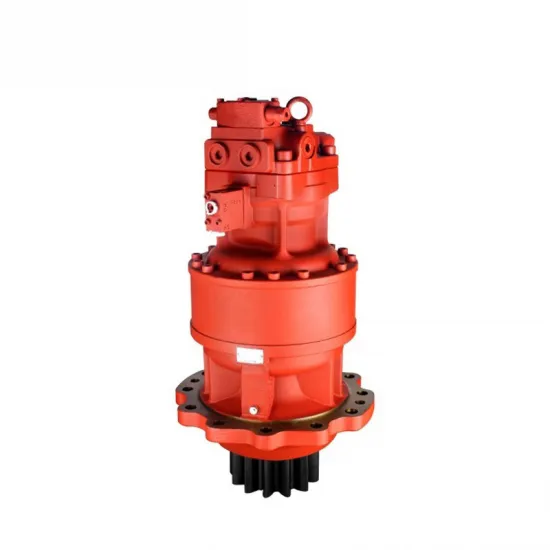
Ekskavaator swing drives are critical components in the operation of excavators, providing the rotational force needed to swing the upper structure of the machine. Understanding the different types of swing drives and their functionalities can help in selecting the right equipment for your needs and ensuring proper maintenance.
A swing drive, also known as a slewing drive, is a gearbox that facilitates the rotational movement of the upper part of an excavator. This component is crucial for the maneuverability and efficiency of the machine, allowing it to rotate 360 degrees.
Slewing drives are essential for tasks that require precise positioning and movement, such as digging, lifting, and placing materials. They enhance the versatility of excavators, making them suitable for a variety of construction and industrial applications.
Slewing drives typically consist of a motor, gearbox, and slewing bearing. These components work together to convert hydraulic or electric power into rotational movement, enabling the upper structure of the excavator to swing.
Hydraulic swing drives are the most common type used in excavators. They utilize hydraulic fluid to generate the necessary force for rotation.
Hydraulic swing drives offer several benefits, including high torque output, smooth operation, and the ability to handle heavy loads. They are also relatively easy to maintain and repair, making them a popular choice for many operators.
Despite their advantages, hydraulic swing drives can be prone to leaks and require regular maintenance to ensure optimal performance. Additionally, they may not be as energy-efficient as other types of swing drives.
Electric swing drives use an electric motor to generate rotational movement. These drives are becoming increasingly popular due to their energy efficiency and environmental benefits.
Electric swing drives are known for their high efficiency, low maintenance requirements, and reduced environmental impact. They also offer precise control over the rotation speed and direction, making them ideal for applications that require accuracy.
However, electric swing drives can be more expensive to purchase and install compared to hydraulic drives. They also require a reliable power source, which may not be available in all job sites.
Hybrid swing drives combine the benefits of both hydraulic and electric systems. These drives use a combination of hydraulic fluid and electric power to generate rotational movement.
Hybrid swing drives offer the best of both worlds, providing high torque output, energy efficiency, and precise control. They are also more versatile and can be used in a wider range of applications.
The main drawback of hybrid swing drives is their complexity and higher cost. They require specialized maintenance and repair, which can be more challenging and expensive compared to other types of swing drives.
When selecting a swing drive, it is important to consider the load capacity of the excavator. Different types of swing drives have varying load capacities, and choosing the right one ensures optimal performance and safety.
The rotation speed of the swing drive is another crucial factor. Depending on the application, you may need a drive that offers higher or lower speeds. Ensure that the chosen swing drive meets the specific speed requirements of your operations.
Regular maintenance is essential for the longevity and performance of swing drives. Consider the maintenance requirements of each type of swing drive and choose one that aligns with your maintenance capabilities and resources.
The cost of the swing drive, including installation and maintenance, should also be taken into account. While some types of drives may have a higher upfront cost, they could offer savings in the long run through reduced maintenance and increased efficiency.
Conducting regular inspections of the swing drive is crucial to identify any signs of wear and tear. Check for leaks, unusual noises, and other indicators of potential issues.
Proper lubrication is essential for the smooth operation of swing drives. Use the recommended lubricants and follow the manufacturer’s guidelines for lubrication intervals.
Over time, certain components of the swing drive may need to be replaced. Regularly check the condition of the bearings, gears, and seals, and replace them as needed to prevent failure and ensure optimal performance.
For complex maintenance tasks and repairs, it is advisable to seek professional servicing. Trained technicians have the expertise and tools to handle intricate repairs and ensure that the swing drive is in top condition.
Leaks are a common issue with hydraulic swing drives. If you notice hydraulic fluid leaking from the drive, it is important to address the issue promptly. Check the seals and hoses for any damage and replace them if necessary.
Unusual noises, such as grinding or knocking sounds, can indicate problems with the swing drive. Inspect the gears, bearings, and other components to identify the source of the noise and take corrective action.
If the swing drive is not performing as expected, it could be due to a variety of factors, including low hydraulic fluid levels, worn-out components, or electrical issues. Conduct a thorough inspection and address the root cause of the problem to restore optimal performance.
Overheating can occur in both hydraulic and electric swing drives. Ensure that the drive is properly lubricated and that the cooling system is functioning correctly. If overheating persists, seek professional assistance to diagnose and resolve the issue.

Understanding the different types of excavator swing drives and their functionalities is essential for selecting the right equipment and ensuring proper maintenance. Whether you choose a hydraulic, electric, or hybrid swing drive, regular maintenance and timely troubleshooting are key to maximizing the performance and longevity of your excavator. By following the tips and guidelines outlined in this blog, you can keep your swing drive in top condition and ensure the smooth operation of your excavator.